If you’re looking for help to identify native birds in Florida, this will be the best article you read today.
In this post, you will find photos, identification info, songs and calls, and all the fun information you need.
Examples of birds native to Florida include the American purple gallinule, black vulture, brown pelican, Florida scrub-jay, limpkin, great blue heron, and many others.
Here are the 25 most interesting ones.
Table of Contents
Birds Native To Florida
American Purple Gallinule

- Scientific Name: Porphyrio martinicus
- Lifespan: up to 25 years
- Wingspan: 20-24 in
- Range In Florida: Throughout Florida
American purple gallinules are Florida’s most beautiful native waterbirds.
These medium-sized rails have long yellow legs with huge feet that help them walk on floating vegetation. Males are bigger than females and have a purple-blue color with green backs, white undertails, pale blue shields on the foreheads, and red and yellow beaks.
American purple gallinules are common around freshwater marshes of Central and Southern Florida year-round; some populations will only spend summers in North Florida.
To communicate when flying, purple gallinules will emit cackling “kek-kek-kek” sounds.
Source: Jamescandless, CC BY-SA 3.0, via Wikimedia Commons
They swim on the surface of the water like ducks and walk on floating vegetation like chickens.
Purple gallinules are usually found alone, especially around places that have a lot of water lilies, lotus, water hyacinth, and hydrilla.
These colorful blue and green waterbirds are monogamous and mate for life. They are also omnivores and consume seeds, leaves, fruits, insects, spiders, frogs, snails, and fish.
The native purple gallinules look very similar to purple swamphens, but are smaller and have yellow instead of reddish legs.
American White Ibis

- Scientific Name: Eudocimus albus
- Lifespan: 16 years in the wild
- Wingspan: 38 in
- Range In Florida: Throughout Florida
American white ibises are wetland birds that are native to Florida.
They have all-white plumage and black wing tips seen during flight. They also have very long legs, pink facial skins, and long necks held straight in flight.
American white ibises have bright red-orange downcurved beaks that become pink with black tips during the breeding season.
White ibises are one of the most numerous wading birds in Florida and can be seen there throughout the year as they are permanent residents. They inhabit shallow coastal marshes, wetlands, mangrove swamps, and even parks and golf courses.
American white ibises make several sounds, including the honking “urnk-urnk” call they use in flight or when agitated, and the muted “huu-huu” call when foraging.
They are very social birds with some colonies including over 30,000 birds.
In Florida, they breed during spring and summer, females lay between two and four eggs, and both parents take turns in incubating the eggs.
One field study in Florida discovered that white ibises spent around 10 hours a day looking for food, less than an hour flying, and 13 hours resting and roosting.
They are carnivores and consume crabs, crayfish, fish, snakes, frogs, and insects that they find by probing the ground with their long beaks.
White ibises are protected by the U.S. Migratory Bird Treaty Act – it is illegal to hunt them.
Anhinga

- Scientific Name: Anhinga anhinga
- Lifespan: 12 years
- Wingspan: 45 in
- Range In Florida: Throughout Florida
Anhingas are large waterbirds that are native to Florida.
They inhabit lakes, freshwater marshes, ponds, and canals and are also called snakebirds, darters, or water turkeys.
Males are black with white spots on their wings and backs; females are similar but have brownish necks and heads.
While swimming, they will keep their long necks above the water, making them look like snakes, hence the nickname snakebird.
Anhingas are permanent residents of Florida and can be seen throughout the state year-round.
They have loud clicking calls that resemble sewing machines or croaking frogs.
Source: National Park Service, Public domain, via Wikimedia Commons
Anhingas have very long and dagger-like beaks they use for hunting and spearing fish. Besides fish, these carnivores will also consume insects, shrimp, crayfish, and sometimes even young alligators and snakes.
In Florida, they particularly like to consume killifish and sunfish and bass.
They do not have waterproof wings as other birds do and can be often seen drying their feathers in the sun.
Black Vulture

- Scientific Name: Coragyps atratus
- Lifespan: 10 years in the wild
- Wingspan: 52-66 in
- Range In Florida: Throughout Florida
There are two vulture species native to Florida, black vultures and turkey vultures.
Black vultures are aggressive large raptors with black plumage, bare black heads, chalky white feet and legs, short, hooked beaks, and white wing patches that can be seen during flight. Both sexes look similar.
They are often mistaken for turkey vultures; the main difference is the bigger size and wider wings and tails in turkey vultures. In addition, black vultures flap their wings more frequently when flying.
Black vultures are permanent residents of Florida and can be seen there throughout the year. They are common around open areas and the woods of the state.
Although quiet most of the time, black vultures will make hissing sounds when feeding and fighting.
These highly gregarious birds might form large communal roosts at night with turkey vultures.
They are carnivores and primarily feed on carrion; black vultures may also hunt and eat small reptiles, birds, and mammals. They will spend most of their day looking for food.
To escape from danger, these large black birds will regurgitate partially digested food to distract the attacker and become lighter before flying away.
Black vultures are monogamous and pairs are believed to mate for life – both the male and female will take turns incubating their eggs.
Black vultures are protected under the Migratory Bird Treaty Act and you can’t kill them without a permit.
They are one of many common birds of Central Texas, East Tennessee, and Western Pennsylvania.
Brown Pelican

- Scientific Name: Pelecanus occidentalis
- Lifespan: 20-40 years
- Wingspan: 11-13.7 in
- Range In Florida: Coasts of Florida
Brown pelicans are native pelicans of Florida and the second-largest species found there, right after American white pelicans.
They are one of the most stunning sights on Florida’s shores; large, distinctive birds, silently gliding up or down the coastline with an occasional beat of their strong wings.
They have chestnut-and-white necks, white-colored heads with pale yellow crowns, brown-streaked backs, rumps, and tails, and black legs and feet. Their huge beaks are gray and can measure up to 13.7 inches in length.
Brown pelicans are permanent residents on the coasts of Florida and can be seen just about everywhere throughout the year.
This wasn’t always the case.
Until the 20th century, people were hunting brown pelicans heavily for their plumage. So in 1903, USA president Theodore Roosevelt established Pelican Island near Sebastian in Indian River County to protect the species.
In South Florida, nesting season begins in the fall; in central and northern Florida, it’s in early spring.
Brown pelicans are monogamous for a single season, and after mating, the pair will build their nest either on the ground or in trees.
Males will bring the building material and the females will build the nests. Usually, a female will lay 1-4 eggs per season.
Pelicans need to eat up to four pounds of fish (and perhaps some shrimp) per day to survive. They will even dive as deep as 30 feet to catch prey with huge pouches under their beaks.
Brown-headed Nuthatch
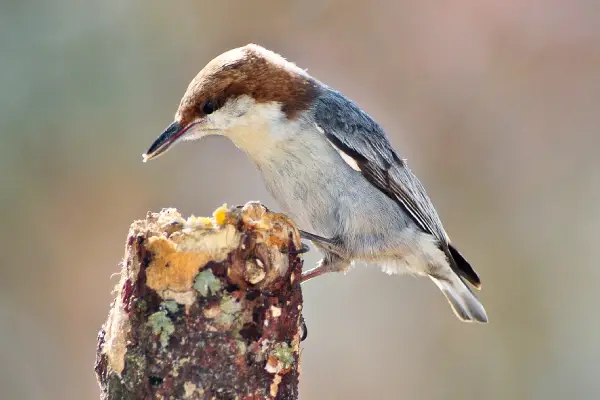
- Scientific Name: Sitta pusilla
- Lifespan: up to 9 years
- Wingspan: 6-7 in
- Range In Florida: Central and Northern Florida (including the Panhandle)
Brown-headed nuthatches are endemic birds of Florida with long beaks and short tails.
They have gray upperparts, white underparts, brown caps, and white spots on the back of their heads.
Brown-headed nuthatches are permanent residents of pine forests of Central and Northern Florida and can be seen there throughout the year. They breed in the state from March to July and lay 4-5 white eggs with reddish-brown spots.
Brown-headed nuthatches have two-syllable songs that resemble toy rubber ducks being squeezed; their call is a soft “pit pit pit” emitted when flying.
Brown-headed nuthatches are omnivores that consume insects and pine seeds. To get to insects and spiders underneath tree bark, these nuthatches will take tools, small wood pieces, and use them to pry up other pieces of bark.
Brown-headed nuthatches are common visitors of feeding stations; add sunflower seeds and suet cakes to attract them to your backyard.
These common Florida songbirds are one of the smallest bird species in the world with a length of 3.5-4.3 in and a weight of 0.35-0.42 oz.
Burrowing Owl
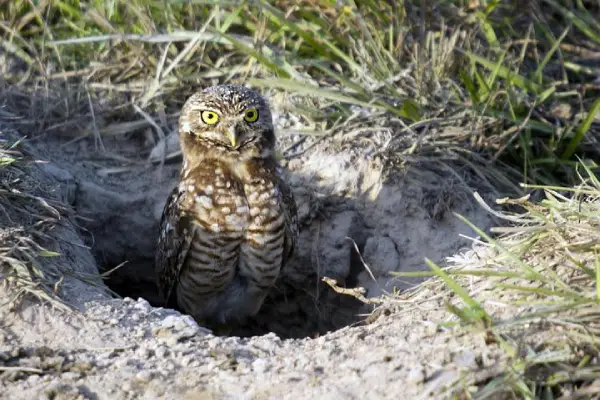
- Scientific Name: Athene cunicularia
- Lifespan: 6-8 years
- Wingspan: 20-24 in
- Range In Florida: Central and Southern Florida
Burrowing owls are the native owls of Florida.
They are also the only owl species that nest underground.
You will identify them in person by their bright eyes, long grayish legs, and lack of ear tufts. These owls have brown heads and wings with white spots and white bellies.
Burrowing owls are permanent residents of Florida and can be seen there around open areas with no trees, including grasslands, rangelands, agricultural areas, and deserts. They breed in the state from February to July.
They mate for life and lay 4-12 eggs that females incubate while the males feed them.
Burrowing owls aren’t very vocal but will still make various sounds: clucking, screaming, rattling, etc. They will often make a two-note cooing call when mating or defending territory.
These Florida natives spend most of their time on the ground; thanks to their long legs, they can have a good view of the horizon.
Burrowing owls are small birds of prey that feed on insects, snakes, frogs, rodents, lizards, and birds.
What makes them unique compared to other owls is their habit of nesting and roosting in burrows made by themselves or prairie dogs and being active during the day in the breeding season.
Carolina Chickadee
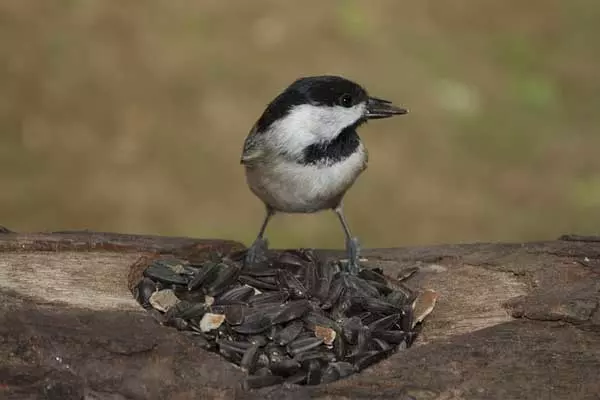
- Scientific Name: Poecile carolinensis
- Lifespan: up to 10 years
- Wingspan: 6-8 in
- Range In Florida: Central and Northern Florida
Caroline chickadees are small songbirds native to Florida.
They have distinctive black caps and bibs, dull white cheeks, gray backs, and white underparts. Their beaks are dark, their wings are short, and their tails are moderately long.
Carolina chickadees are permanent residents of the central and northern parts of Florida and can be seen there throughout the year.
They are non-migratory birds that are common in tree branches of mixed and deciduous woods hopping along in search of insects.
They look similar to black-capped chickadees – the main difference between the two species is the Carolina chickadees’ smaller size and the lower and fuller voice of black-capped chickadees.
The song of Carolina chickadee consists of 4 notes that sound like “fee-bee-fee-bay” and the call they were named after, is a familiar “chick-a-dee-dee.”
Source: G. McGrane, Public domain, via Wikimedia Commons
When the weather gets very cold, instead of migrating south, Carolina chickadees will enter torpor – a hibernation-like state of sleep where they lower their body temperature, breathing rate, heart rate, and metabolic rate to survive the winter months.
During summer, they mainly consume insects; when winter comes, they add in some seeds and berries. They might also store food for later use.
Attract Carolina chickadees to your backyard by adding black oil sunflower seeds, hulled sunflower seeds, shelled peanuts, suet, and peanut butter to your feeders.
They are also one of many songbirds that live in North Carolina. Find the list here.
Crested Caracara
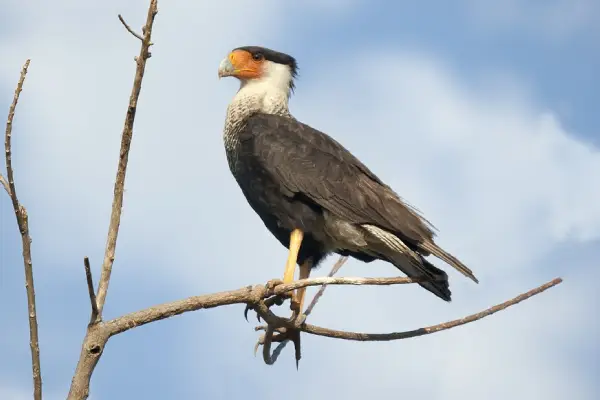
- Scientific Name: Caracara cheriway
- Lifespan: up to 30 years
- Wingspan: 47-52 in
- Range In Florida: Central Florida
Native to Florida, crested caracaras are large raptors found around cattle ranches, farms, and fields of the state.
They are dark brown overall and have white necks, black caps on their white heads, orange facial skin, and long yellow legs.
Crested caracaras are permanent residents of Central Florida and can be seen there throughout the year. They breed there from September to April; the peak of the breeding season is from January to March.
Some Florida counties where they can be seen today are the Highlands, DeSoto, Okeechobee, Glades, Hendry, and Osceola.
Although mainly quiet, crested caracaras might make some rattling sounds, like moving a stick along the fence, during the breeding season.
Source: Oliver Komar, CC BY-SA 4.0, via Wikimedia Commons
With a length of up to 26 in, a wingspan of up to 52 in, and a weight of up to 3.5 pounds, crested caracaras are the second-largest species of falcon in the world, smaller only than the gyrfalcon.
Crested caracaras are opportunistic feeders that eat carcasses, food of other raptors, insects, and some fruit. These white-headed falcons will often chase away black and turkey vultures from roadkills.
Read More: More examples of birds found in Central Florida
Fish Crow

- Scientific Name: Corvus ossifragus
- Lifespan: up to 14 years
- Wingspan: 32-34 in
- Range In Florida: Throughout Florida
Fish crows are endemic to Florida and look like smaller versions of the American crows.
They have sturdy legs, heavy bills, and broad wings; their plumage is all-black, their eyes are dark brown, and their tails are longer than those of American crows.
Fish crows are permanent residents of Florida and can be seen throughout the state around coastal, urban, and inland areas near large lakes.
Listen for their nasal “ark-ark-ark” and mechanical rattle calls.
They have a particular habit of robbing nests – fish crows will raid the nests of many kinds of waterbirds and songbirds or dig up turtle eggs.
They are omnivores that feed on fish, crabs, shrimps, fruits, grains, peanuts, and even human scrap.
Fish crows often forage on the ground or in shallow waters where they can be seen plucking food out of the water with their feet.
Florida Grasshopper Sparrow
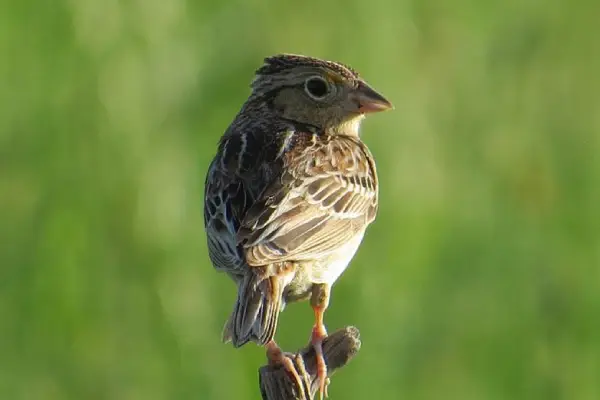
- Scientific Name: Ammodramus savannarum floridanus
- Lifespan: n/a
- Wingspan: 8 in
- Range In Florida: South-central Florida
Florida grasshopper sparrow is an endangered subspecies of grasshopper sparrows that is native to dry open prairies with bunch grasses and low shrubs of south-central Florida.
You will identify these small birds by their short tails and round heads. They have brown, white, and gray wings, white undersides, and buff bellies.
They were named after their songs that sound like grasshoppers. Males sing only a few hours a day when the breeding season comes, usually around sunrise and sunset.
Source: Jonathon Jongsma, CC BY-SA 3.0, via Wikimedia Commons
In Florida, these grasshopper sparrows are common in counties: Glades, Polk, Osceola, Highlands, and Okeechobee.
They are omnivores and feed on seeds and grasshoppers.
Florida grasshoppers sparrows nest from April to August in the state and lay 3-5 eggs that both parents incubate.
Florida Scrub-jay

- Scientific Name: Aphelocoma coerulescens
- Lifespan: up to 15 years
- Wingspan: 13-14 in
- Range In Florida: Central Florida
Florida scrub-jays are endemic to Florida and are the only bird species that live exclusively in that state.
These large and sturdy songbirds have gray on the center of their backs, blue tails, wings, and heads, and gray underparts. Florida scrub-jays also have whitish foreheads and throats and have no crests.
Florida scrub-jays are mostly found in central Florida and can be seen there year-round.
According to some 2019 estimates, the largest 3 populations of these birds can be found at Ocala National Forest in Marion County, Brevard County, and Highlands County.
Florida scrub-jays are common in the Florida scrub habitat, an ecosystem that exists only in central parts of the state. They inhabit sand pine and xeric oak scrubs, and scrubby flatwoods.
Listen for the songs of Florida scrub-jas that include trills and high warbles. Their call is a loud harsh “shreep.”
These blue-winged birds are cooperative breeders – fledglings will stay with their parents for several years, help rear the young, watch for predators, and defend territory. Such families can include 2-8 birds.
Florida scrub-jays are listed as a threatened state species with some estimates claiming that around 4,000 individuals are left in the wild. The International Union for Conservation of Nature classifies them as vulnerable to extinction.
They are omnivores and feed on acorns, seeds, peanuts, insects, tree frogs, turtles, snakes, lizards, and young mice.
According to some studies, Florida scrub-jays have been living in Florida for at least 2 million years and possibly originated from the ancestors of Woodhouse’s scrub-jays.
Killdeer
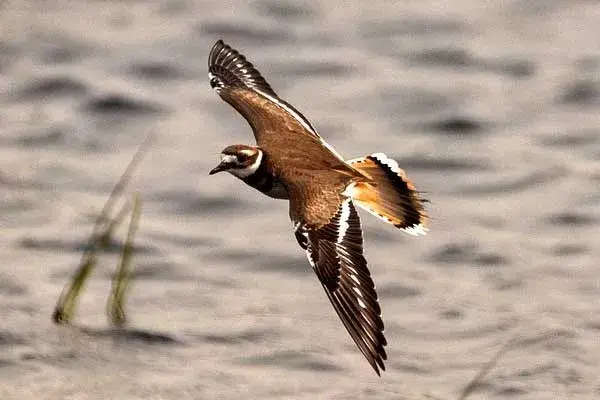
- Scientific Name: Charadrius vociferus
- Lifespan: up to 11 years
- Wingspan: 18-25 in
- Range In Florida: Throughout Florida
Killdeer is a very common shorebird of Florida.
It is widespread and has brown plumage above with two black breast bands, orange tails, pink legs, and slender wings with conspicuous white wing stripes at their base.
Killdeers are permanent residents of central and northern Florida and can be seen in beach habitats and coastal wetlands and fields of the state year-round.
These birds are masters of distraction that might fake a ‘broken-wing‘ display where they flutter along the ground in a show of injury, to distract predators from their nests.
Killdeers are omnivorous and feed on insects, including beetles, caterpillars, grasshoppers, fly larvae, spiders, earthworms, centipedes, crayfish, snails, and some seeds.
They got their name from the loud piercing calls that sound a little like “kill-deer, kill-deer”.
Source: Unknown author, Public domain, via Wikimedia Commons
Killdeers will often have two broods per year with a clutch size of 3-5 eggs that both parents incubate.
Ivory-billed Woodpecker

- Scientific Name: Campephilus principalis
- Lifespan: n/a
- Wingspan: 29-31.5 in
- Range In Florida: n/a
Ivory-billed woodpeckers are very rare woodpeckers native to the bottomland hardwood forests and temperate coniferous forests of Florida.
The last widely accepted sighting of the ivory-billed woodpecker in North America was back in 1944. They are the third-largest woodpeckers in the world that were once common from the Carolinas and Florida to Texas, but were nearly declared extinct.
The species historically inhabited mature bottomland forests associated with river basins throughout the southeastern United States, with a small, separate population in Cuba.
A group of scientists climbing through Arkansas, Louisiana, and Florida forests published a report (not peer-reviewed) claiming that they discovered the bird, taking several photos, videos, and audio recordings in the process.
These birds are mostly black with two white stripes down the neck and large white panels on the upper wings – males have red crests and females with black ones.
Limpkin

- Scientific Name: Aramus guarauna
- Lifespan: n/a
- Wingspan: 40 in
- Range In Florida: Central, Southern, and Northern Florida (without the Panhandle)
Limpkins are large wading birds that are native to Florida.
They can be identified by their large necks, curved beaks, and heavy bodies; they weigh almost 3 pounds.
Males are larger than females, but both sexes look alike. They are mostly brown and have white spots and streaks that are densest on their heads and necks. Their beaks are slightly open closer to the mouth but closed at the tip, similar to tweezers, allowing them to grab apple snails with ease.
Limpkins are permanent residents of Florida and can be seen around freshwater marshes and swamps. They nest in the state from February to June.
Limpkins will often make loud screaming “klaaar” calls, clucks, piercing “bihks,” etc.
Source: Niels Krabbe, CC BY-SA 4.0, via Wikimedia Commons
They love to forage in shallow waters, and besides their favorite apple snails, they might also consume some insects, frogs, lizards, worms, and seeds.
Some individuals are monogamous for a season or two. Both partners will take turns in incubating the clutch of 3-8 eggs. Limpkins were named after their slow gait that resembles limping.
Great Blue Heron

- Scientific Name: Ardea herodias
- Lifespan: 15 years
- Wingspan: 66–79 in
- Range In Florida: Through Florida
Great blue herons are one of the largest native birds of Florida.
They are blue-gray, have short black plumes on their heads, and black and chestnut patterns on the shoulders. Their very long yellowish beaks become orange during the breeding season and measure up to 7 inches in length.
During the flight, they will hold their necks in an S-shape with legs trailing behind.
Great blue herons are permanent residents found in wetlands throughout Florida. In south Florida and the Florida Keys, there is a native all-white subspecies of great blue herons known as the great white heron.
Great blue herons have several vocalizations, including squawking “roh-roh,” screaming “awk,’ and clucking “go-go” calls.
Source: G. McGrane, Public domain, via Wikimedia Commons
These birds will perform some interesting courtship rituals – they will lock and rub their beaks on the feathers of the other bird before mating.
Great blue herons are monogamous only for a single season and both parents will take turns in incubating the eggs.
They are carnivores that feed on fish, amphibians, reptiles, invertebrates, small mammals, and even other birds. Great blue herons hunt by slowly stalking their prey in shallow waters, striking with lightning speed, and spearing it with their long and sharp beaks.
Read More: More examples of stunning birds with huge beaks in Florida
Mottled Duck

- Scientific Name: Anas fulvigula
- Lifespan: 5 years
- Wingspan: 32-34 in
- Range In Florida: Central and southern Florida
Mottled ducks are medium-sized waterfowl that are native to Florida.
Both sexes look similar and resemble female mallards – mottled ducks have overall mottled brown plumage. Males and females have a shiny green-blue wing patch. The main difference is the beak; males have bright yellow, while females have deep to pale orange beaks.
Mottled ducks are permanent residents of Florida and can be seen around freshwater marshes and ponds in central and southern parts.
Florida is home to one subspecies of mottled ducks, the Florida mottled duck (A. f. fulvigula), which occurs south of Tampa and has lighter colors and less heavily marked plumage compared to other subspecies.
Florida mottled ducks nest in the state from February to July.
Mottled ducks make similar sounds to mallards: males will emit low, raspy calls and the females will make a loud series of quacks. Females might also make soft “tickety-tickety” calls when flying.
These ducks do not migrate and feed on insects, snails, mollusks, crayfish, small fish, seeds, stems, and roots.
Mourning Dove

- Scientific Name: Zenaida macroura
- Lifespan: 2 years in the wild
- Wingspan: 12 in
- Range In Florida: Throughout Florida
Mourning doves are the only dove species native to Florida, according to the University of Florida.
They are also one of the most widespread birds in North America. Mourning doves were named after the sad cooing sounds they make while singing.
They have broad wings, rounded heads, and brown-gray plumage overall with black spots on the wings. Their tails are long and pointed, the legs are red.
Mourning doves are permanent residents of Florida and can be seen around open areas, forest edges, farms, parks, and urban areas throughout the year.
Mourning doves have several vocalizations: distinctive “coo-woo-woo” calls when attracting females, soft greeting “ork” calls, and short “roo-oo” alarm calls.
Source: Jonathon Jongsma, CC BY-SA 3.0, via Wikimedia Commons
They are excellent at breeding and can raise up to 12 young per year. Mourning doves are monogamous and both parents incubate the eggs and raise the young.
Mourning doves are omnivores with seeds making 99% of their diet; they might also consume some insects or snails.
Northern Cardinal

- Scientific Name: Cardinalis cardinalis
- Lifespan: 3 years
- Wingspan: 10-12 in
- Range In Florida: Throughout Florida
Northern cardinals are medium-sized Florida songbirds.
Males have bright red plumage with crests on their heads and black throats and faces; females are brown with head crests and with reddish wings and tails.
Northern cardinals have beautiful orange bills and can be seen year-round throughout Florida, around woodlands, brushy fields, parks, backyards, and other urban areas of the state.
Their song is 2-3 seconds long and consists of a loud string of clear down-slurred or two-parted whistles that sound like “cheer-cheer,” “birdie-birdie,” and “wheet-wheet.”
Source: G. McGrane, Public domain, via Wikimedia Commons
Northern cardinals’ most common call is a loud, metallic chip they use to chase other males entering their territories.
These birds are very territorial and aggressive – northern cardinals will often try to ferociously attack their reflections in the mirrors and windows.
They are also known as redbirds and they get their red color from the food they eat – if there are not enough carotenoids in their food, they become brownish. They are omnivores that feed on seeds, fruit, and insects.
You can easily attract northern cardinals to your bird feeder, especially if you add some sunflower seeds, peanut hearts, millet, or milo.
Red-shouldered Hawk
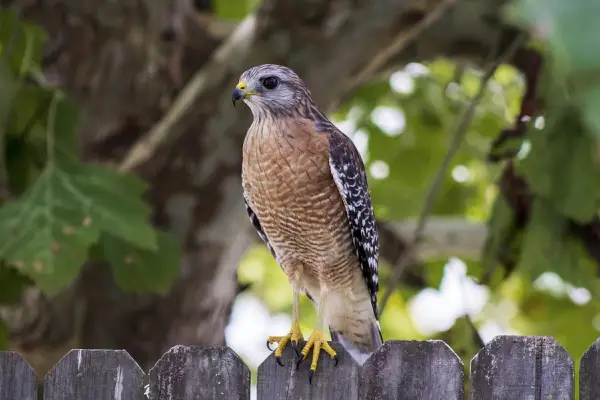
- Scientific Name: Buteo lineatus
- Lifespan: 15-19 years
- Wingspan: 35-50 in
- Range In Florida: Throughout Florida
Red-shouldered hawks are one of many hawks native to Florida.
These extremely vocal North American birds inhabit woods, farms, and urban areas, often near water.
They can be identified by narrow white bands on their black tails, reddish shoulders, grayish backs, and fine reddish banding on light-colored chests.
Red-shouldered hawks are permanent residents throughout Florida and breed in the state around late winter through spring, from January to May. They usually have a clutch of 2-4 eggs that the female incubates while the male feeds her.
Red-shouldered hawks have a loud, piercing “kee-yeeear” call and can be often heard before being spotted. When the breeding season comes, they become extremely vocal.
Source: G. McGrane, Public domain, via Wikimedia Commons
Red-shouldered hawks will perch on tree branches and utility wires and scan the area. As they spot their prey, they will swoop down and snatch it from the ground or water surface.
These fairly large raptors are carnivores and feed on small mammals, birds, reptiles, amphibians, and crayfish.
Red-shouldered hawks are monogamous and very territorial birds.
Read More: List of hawks with white heads
Roseate Spoonbill

- Scientific Name: Platalea ajaja
- Lifespan: 10-15 years
- Wingspan: 50 in
- Range In Florida: Southern and Central Florida
Roseate spoonbills are large birds native to Florida and one of the state’s most unique species.
They are pink overall with white necks, extremely long spoon-shaped beaks, and featherless heads. They get their pink coloration from the pigments called carotenoids – crustaceans and other aquatic invertebrates spoonbills consume are full of them.
Roseate spoonbills are permanent residents in the state and can be seen throughout the year along the coastline of Southern Florida, from the southern islands of Florida Keys, Florida Bay, and Everglades, up to Tampa.
Mainly quiet until the breeding season comes, roseate spoonbills will make low grunting sounds or faint rattling sounds by clicking their beaks together.
Look for groups of pink birds foraging in the shallows of fresh and saltwater, often with egrets and ibises nearby.
They are carnivores that eat crustaceans, aquatic insects, frogs, newts, and very small fish.
Roseate spoonbills breed in Southern Florida from November to December; in Central Florida, that happens around April.
They will build their nests in dense mangroves or trees, and lay 2-5 whitish eggs with brown marks.
Similar to humans, these birds will lose feathers from the top of their heads as they get older.
Read More: More examples of pink-colored birds from Florida
Snail Kite
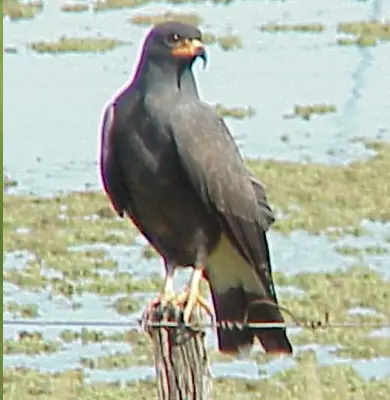
- Scientific Name: Rostrhamus sociabilis
- Lifespan: up to 14 years
- Wingspan: 39–47 in
- Range In Florida: Central and Southern Florida
Snail kites have a population native to Florida that is federally listed as Endangered.
These medium-sized raptors have broad wings, long legs, broad tails, and hooked beaks. Males have charcoal bodies, red-range beaks and legs, white rumps, and creamy tail bands; females are slightly larger and are mottled brown.
Snail kites are permanent residents of Central and Southern Florida and can be seen around freshwater marshes. They breed in the state from February to August.
Snail kites were named after their favorite food, apple snails. They are usually solitary or in pairs during summer; when the winter comes, they will roost together in groups.
Snail kites will often make quick “ka-ka-ka” alarm calls or softer “kuk-kuk” contact calls.
Source: Niels Krabbe, CC BY-SA 4.0, via Wikimedia Commons
Some great places in Florida to see snail kites include lakes Kissimmee, Okeechobee and Tohopekaliga, Loxahatchee National Wildlife Refuge, water conservation areas (Everglades), and stretches of the Tamiami Trail.
One subspecies of snail kites found in the Florida Everglades is the Everglade snail kite (Rostrhamus sociabilis plumbeus). These birds are endangered and some estimates claim around 400 pairs living there.
Tricolored Heron
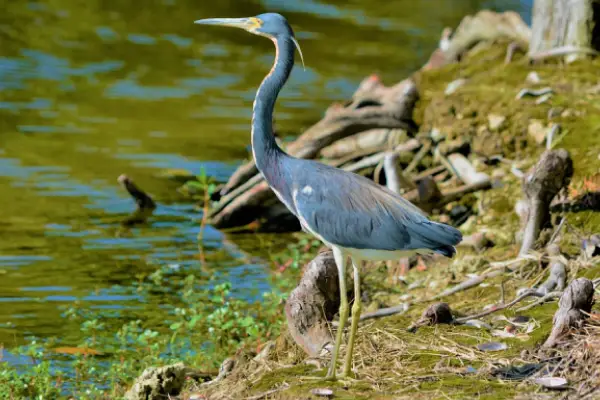
- Scientific Name: Egretta tricolor
- Lifespan: up to 17 years in the wild
- Wingspan: 36-38 in
- Range In Florida: Throughout Florida
Tricolored herons are large birds native to Florida.
They can be identified by their long legs, necks, and beaks; they have grayish-blue upperparts, bright white undersides, and yellow legs.
Tricolored herons are permanent residents of Florida and can be found statewide along its shorelines, lakes, ponds, and marshes. They breed there from February to August.
Tricolored herons have alarm calls that sound like a repeated “aahrr“.
These native Florida birds are carnivores that mainly feed on fish, amphibians, insects, and crustaceans. They will stalk in shallow or deeper waters or dart around erratically and chase after the prey.
Tricolored herons are social birds that nest in colonies together with other heron species. They will use sticks to build their nests in trees and shrubs and lay 3-7 eggs.
White-eyed Vireo
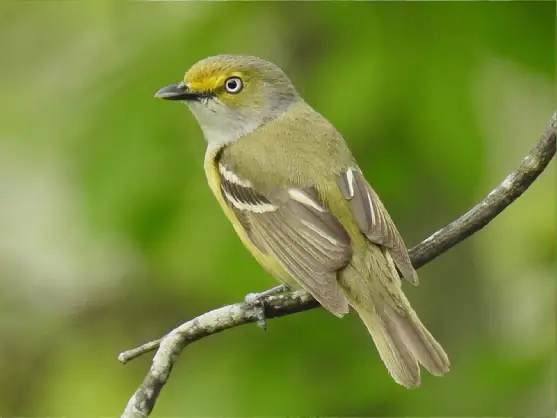
- Scientific Name: Vireo griseus
- Lifespan: up to 11 years
- Wingspan: 6.7 in
- Range In Florida: Throughout Florida
White-eyed vireos are small songbirds that weigh around 0.4 oz and were named after their eyes with white irises.
They are olive above, white below, green on their sides, gray on their necks, and dark on their wings.
White-eyed vireos are permanent residents of Florida, common around woods and marshes of the state.
They have a song that consists of rapid 6-7 notes that start and end with a sharp “chick“.
Source: G. McGrane, Public domain, via Wikimedia Commons
White-eyed vireos are omnivores that mainly feed on insects during summer and add berries to their diets when the winter comes.
There are 6 subspecies of white-eyed vireos; the one found in Florida is the v. g. maynardi which is grayer above and whiter below.
Wood Stork
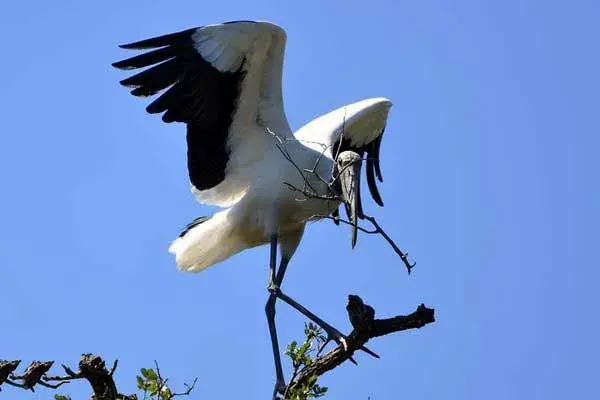
- Scientific Name: Mycteria americana
- Lifespan: up to 27 years
- Wingspan: 55–71 in
- Range In Florida: Central and southern Florida
Wood storks are the only species of storks that are native to Florida.
These storks might not bring babies but are still one of the largest birds found in Florida.
They have white plumage with black edges on the back side of the wings, naked dark gray heads and necks, long legs, and long, slightly curved black beaks.
Wood storks are permanent residents of central and southern Florida and are commonly found around freshwater marshes, lakes, ponds, and canals.
They breed in the state during the late winter dry season.
Wood storks are listed as threatened in the US. After three-decade-long conservation and recovery efforts, the species moved from endangered to threatened species in June 2014.
They are very social birds that feed in flocks and nest in large rookeries – sometimes with several pairs on a single tree.
They build large stick nests in the trees, the female will lay two to five eggs, and both of the parents will take turns incubating them for about one month.
To keep their nestlings cool, wood storks will regurgitate water over them.
Summary
This concludes our list of birds native to Florida.
Examples include pelicans, hawks, vultures, jays, herons, owls, ducks, and many others.
Next time, should you see these birds in person, you should be able to recognize any of them with ease!
And if you enjoyed our article, here are our other popular reads on birds: Examples of green-colored Florida birds and Examples of birds living in North Georgia